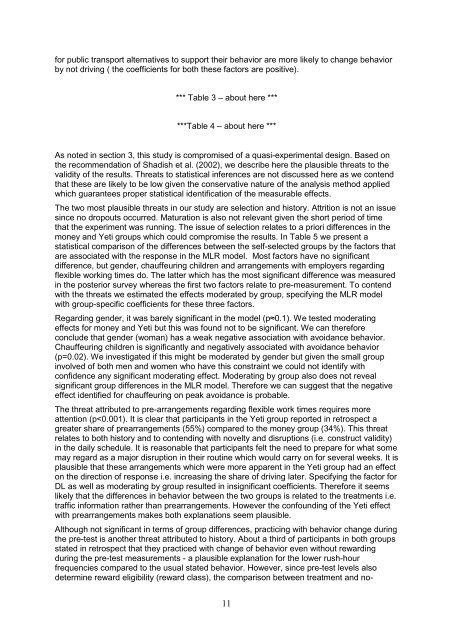Ben-Elia, E. and Ettema, D. (2011) Changing commuters' behav- ior ...
Ben-Elia, E. and Ettema, D. (2011) Changing commuters' behav- ior ...
Ben-Elia, E. and Ettema, D. (2011) Changing commuters' behav- ior ...
Create successful ePaper yourself
Turn your PDF publications into a flip-book with our unique Google optimized e-Paper software.
for public transport alternatives to support their <strong>behav</strong><strong>ior</strong> are more likely to change <strong>behav</strong><strong>ior</strong><br />
by not driving ( the coefficients for both these factors are positive).<br />
*** Table 3 – about here ***<br />
***Table 4 – about here ***<br />
As noted in section 3, this study is compromised of a quasi-experimental design. Based on<br />
the recommendation of Shadish et al. (2002), we describe here the plausible threats to the<br />
validity of the results. Threats to statistical inferences are not discussed here as we contend<br />
that these are likely to be low given the conservative nature of the analysis method applied<br />
which guarantees proper statistical identification of the measurable effects.<br />
The two most plausible threats in our study are selection <strong>and</strong> history. Attrition is not an issue<br />
since no dropouts occurred. Maturation is also not relevant given the short period of time<br />
that the experiment was running. The issue of selection relates to a pr<strong>ior</strong>i differences in the<br />
money <strong>and</strong> Yeti groups which could compromise the results. In Table 5 we present a<br />
statistical comparison of the differences between the self-selected groups by the factors that<br />
are associated with the response in the MLR model. Most factors have no significant<br />
difference, but gender, chauffeuring children <strong>and</strong> arrangements with employers regarding<br />
flexible working times do. The latter which has the most significant difference was measured<br />
in the poster<strong>ior</strong> survey whereas the first two factors relate to pre-measurement. To contend<br />
with the threats we estimated the effects moderated by group, specifying the MLR model<br />
with group-specific coefficients for these three factors.<br />
Regarding gender, it was barely significant in the model (p≈0.1). We tested moderating<br />
effects for money <strong>and</strong> Yeti but this was found not to be significant. We can therefore<br />
conclude that gender (woman) has a weak negative association with avoidance <strong>behav</strong><strong>ior</strong>.<br />
Chauffeuring children is significantly <strong>and</strong> negatively associated with avoidance <strong>behav</strong><strong>ior</strong><br />
(p=0.02). We investigated if this might be moderated by gender but given the small group<br />
involved of both men <strong>and</strong> women who have this constraint we could not identify with<br />
confidence any significant moderating effect. Moderating by group also does not reveal<br />
significant group differences in the MLR model. Therefore we can suggest that the negative<br />
effect identified for chauffeuring on peak avoidance is probable.<br />
The threat attributed to pre-arrangements regarding flexible work times requires more<br />
attention (p

















